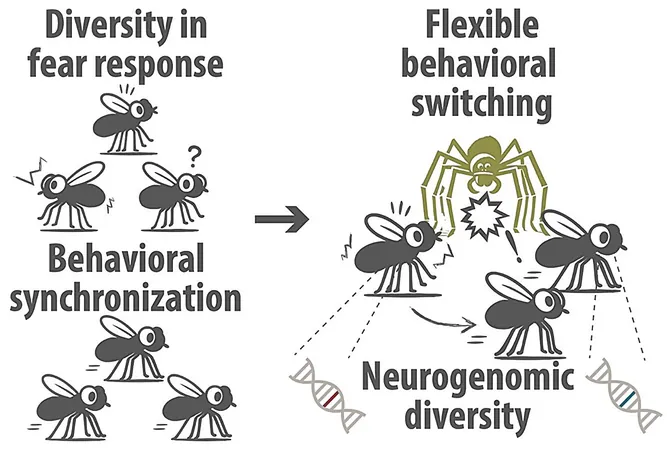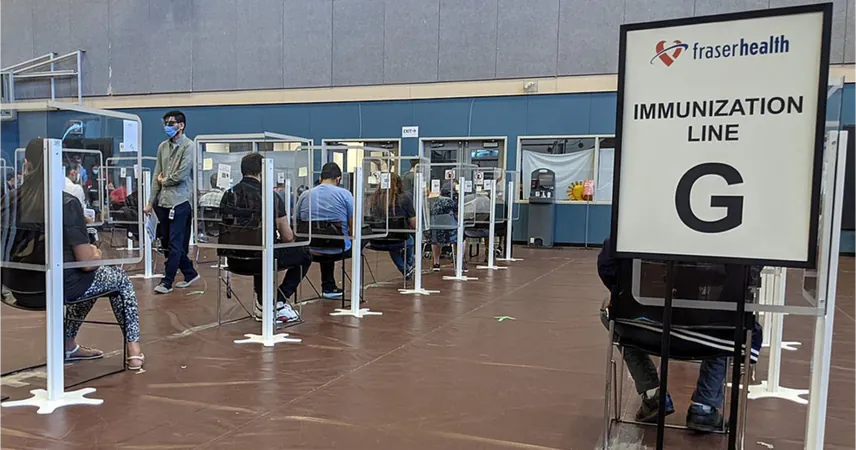
Unlocking Survival Secrets: How Fruit Flies Use Teamwork to Evade Predators
2025-07-07
Author: Emily
The Power of Collective Behavior in Nature
From schools of fish dodging sharks to flocks of starlings swirling in the sky, the animal kingdom showcases incredible instances of group behavior that enhance survival. By working together, animals can efficiently detect predators and coordinate their escape, improving their chances of survival and making food gathering more effective.
Exploring the Unknown: Genetics and Group Dynamics
Despite the observable benefits of collective behaviors, the genetic and neural mechanisms that drive them remain largely mysterious. Traditional genetic studies excel in linking genomic variations to individual traits. However, group behaviors arise from the intricate interactions of multiple individuals, each with different genomes, complicating our understanding.
Fruit Flies to the Rescue: A Unique Research Approach
Addressing this complexity, researchers at Chiba University, led by Assistant Professor Daiki Sato and Associate Professor Yuma Takahashi, focused on an unexpected model: the fruit fly. Their groundbreaking study, published in Nature Communications, investigates how these tiny creatures coordinate their fear responses when confronted by predators.
Behavioral Experiments Yield Surprising Insights
The team conducted impressive experiments with 104 genetically distinct fruit fly lines, examining how both individuals and groups reacted to predator attacks simulated through moving shapes on screens. The results were fascinating—while solitary flies would freeze in fear, their group counterparts quickly resumed normal activity after observing the movements of their peers.
Identifying Key Genes and Their Roles
Utilizing genome-wide association studies (GWAS), the researchers pinpointed specific genes linked to group interactions. Notably, the Ptp99A gene emerged as crucial, influencing how flies respond to their companions. The study found that this gene, which governs certain cellular and neural functions, plays a significant role in the flies' visual processing during fear responses.
A New Methodology: GHAS for Group-Level Analysis
To deepen their analysis, the team introduced an innovative approach called genome-wide higher-level association study (GHAS). This method investigates genetic variations related not just to individual traits but to characteristics displayed by groups, paving the way for a better understanding of collective behavior.
Genetic Diversity: A Booster for Group Survival
Perhaps the most striking finding was that genetic diversity within groups enhances collective survival capabilities. When mixed groups of genetically distinct flies were tested, they exhibited stronger fear responses than expected, improving their chances against predators.
Revolutionary Predation Experiments: Virtual Reality Meets Biology
In an eye-opening experiment, researchers created virtual flies shown on screens to study how real jumping spiders reacted. By varying the freezing durations of these virtual flies, they showed that individual variability, coupled with synchronized behavior, gave groups a significant edge—lowering the risk of predation while maintaining vital foraging activities.
Implications Beyond Fruit Flies: A Broader Impact
This research not only boosts our understanding of how genetic and neural diversity fosters adaptive behaviors but also has wide-ranging applications. Insights gained could influence fields such as pest control, robotic swarm systems, and even the development of strategies for neurodevelopmental disorders.
A Step Forward in Understanding Group Evolution
Overall, this study marks a significant leap in comprehending the biological underpinnings and evolutionary journey of group behaviors. With hope, similar findings could be replicated across different species, unlocking new avenues for utilizing this knowledge.









 Brasil (PT)
Brasil (PT)
 Canada (EN)
Canada (EN)
 Chile (ES)
Chile (ES)
 Česko (CS)
Česko (CS)
 대한민국 (KO)
대한민국 (KO)
 España (ES)
España (ES)
 France (FR)
France (FR)
 Hong Kong (EN)
Hong Kong (EN)
 Italia (IT)
Italia (IT)
 日本 (JA)
日本 (JA)
 Magyarország (HU)
Magyarország (HU)
 Norge (NO)
Norge (NO)
 Polska (PL)
Polska (PL)
 Schweiz (DE)
Schweiz (DE)
 Singapore (EN)
Singapore (EN)
 Sverige (SV)
Sverige (SV)
 Suomi (FI)
Suomi (FI)
 Türkiye (TR)
Türkiye (TR)
 الإمارات العربية المتحدة (AR)
الإمارات العربية المتحدة (AR)